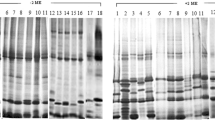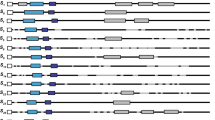Summary
Protein stylar extracts of 16 cultivars of sweet cherry (Prunus avium), from the 10 different incompatibility groups to which incompatibility alleles have been assigned, were separated on acrylamide gels using isoelectric focusing (IEF) and were stained for ribonuclease activity. When two cultivars from the same incompatibility group were analyzed they gave identical zymograms and the cultivars of the 10 different incompatibility groups gave in all eight distinct zymograms. The ribonuclease polymorphism could be correlated with the reported S allele constitutions of the cultivars. Three ribonuclease bands were identified that each consistently corresponded to one of the six known incompatibility alleles (S 1, S2 and S 6), a fourth band apparently corresponded to S 3 and to the combination of S 4 and S 5, and a fifth band to S 4 and S 5 in other combinations. Thus, it seems that S alleles of cherry have ribonuclease activity and that IEF is useful for distinguishing S allele constitutions. The ribonuclease pattern of ‘Summit’, a cultivar of unknown incompatibility group, indicated its incompatibility genotype to be S 1S2, and this was confirmed by controlled pollination. The same band corresponded to S 4 and S 4', the mutant allele in self-compatible cultivars. IEF and ribonuclease staining promise to be useful tools for exploring the incompatibility relationships of cherry cultivars and perhaps of other self-incompatible Prunus crops.
Similar content being viewed by others
References
Brown, A.G., 1955. Department of Plant Breeding. Report of John Innes Horticultural Institution for 1954: 6–11.
Crane M.B. & A.G. Brown, 1937. Incompatibility and sterility in the sweet cherry, Prunus avium L. Journal of Pomology & Horticultural Science 15: 80–116.
Crane M.B. & W.J.C. Lawrence, 1929. Genetical and cytological aspects of incompatibility and sterility in cultivated fruits. Journal of Pomology & Horticultural Science 7: 276–301.
Crane M.B. & W.J.C. Lawrence, 1931. Sterility and incompatibility in diploid and polyploid fruits. Journal of Genetics 24: 97–107.
Kobel F., P. Steinegger & J. Anliker, 1938. Weitere Untersuchungen über die Befruchtungsverhältnisse der Kirschensorten. Landwirtschaftlichen Jahrbuch der Schweiz 52: 564–595.
Lane W.D. & H. Schmid, 1984. Lapins and Sunburst sweet cherry. Canadian Journal of Plant Science 64: 211–214.
Lapins K.O., 1973. Induced mutations in fruit trees. In: Induced Mutations in Vegetatively Propagated Plants, pp. 1–19. IAEA, Vienna.
McClure B.A., V. Haring, P.R. Ebert, M.A. Anderson, R.J. Simpson, F. Sakiyama & A.E. Clarke, 1989. Style self-incompatibility gene products of Nicotiana alata are ribonucleases. Nature 342: 955–957.
Matthews P. & K.P. Dow, 1969. Incompatibility groups: sweet cherry (Prunus avium). In: R.L. Knight (Ed.). Abstract Bibliography of Fruit Breeding & Genetics to 1965, Prunus, pp. 540–544. Commonwealth Agricultural Bureaux, Farnham Royal.
Matthews, P., 1970. The genetics and exploitation of self-fertility in the sweet cherry. Proceedings of the Angers Fruit Breeding Symposium, September 1970: 307–316.
Mau S.L., J. Raff & A.E. Clarke, 1982. Isolation and partial characterisation of components of Prunus avium L. styles, including an antigenic glycoprotein associated with a self-incompatibility genotype. Planta 156: 505–516.
Sansavini S. & S. Lugli, 1994. Il miglioramento genetico del ciliego dolce per l'autofertilià, l'habitus compatto e l'altra qualità del frutto. Rivista di Frutticoltura 56 (6): 19–27.
Sassa H., H. Hirano & H. Ikehashi, 1992. Self-incompatibility-related RNases in styles of Japanese pear (Pyrus serotina Rehd.). Plant Cell Physiology 33: 811–814.
Tehrani G. & W. Lay, 1991. Verification through pollen incompatibility studies of pedigrees of sweet cherry cultivars from Vineland. HortScience 26: 190–191.
Tobutt & Bošković, 1994. Progress in constructing a linkage map for Prunus. Annual Report of Horticulture Research International 1993–94: 35.
Way R.D., 1968. Pollen incompatibility groups of sweet cherry clones. Proceedings of the American Society for Horticultural Science 92: 119–123.
Wilson C.M., 1971. Plant nucleases III. Polyacrylamide gel electrophoresis of com ribonuclease isoenzymes. Plant Physiology 48: 64–68.
Author information
Authors and Affiliations
Rights and permissions
About this article
Cite this article
Bošković, R., Tobutt, K.R. Correlation of stylar ribonuclease zymograms with incompatibility alleles in sweet cherry. Euphytica 90, 245–250 (1996). https://doi.org/10.1007/BF00023865
Received:
Accepted:
Issue Date:
DOI: https://doi.org/10.1007/BF00023865




